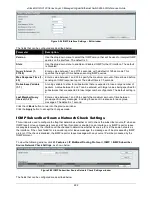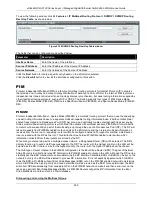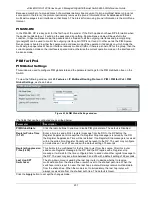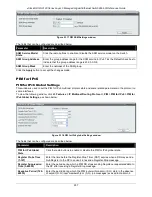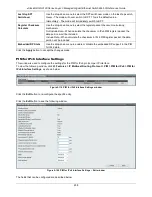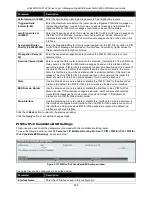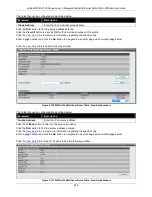
xStack® DGS-3120 Series Layer 3 Managed Gigabit Ethernet Switch Web UI Reference Guide
229
To view the following window, click
L3 Features > IP Multicast Routing Protocol > DVMRP > DVMRP Routing
Next Hop Table
, as shown below:
Figure 5-105 DVMRP Routing Next Hop Table window
The fields that can be configured are described below:
Parameter
Description
Interface Name
Enter the name of the interface.
Source IP Address
Enter the IP address of the Source IP Address.
Source Netmask
Enter the netmask of the Source IP Address.
Click the
Find
button to locate a specific entry based on the information entered.
Click the
View All
button to view all the interfaces configured on this switch.
PIM
Protocol Independent Multicast (PIM) is a family of multicast routing protocols for Internet Protocol (IP) networks
that provide one-to-many and many-to-many distribution of data over a LAN, WAN or the Internet. PIM is protocol-
independent as it does not include its own topology discovery mechanism, but uses routing information supplied by
other traditional routing protocols, such as RIP or OSPF. The Switch supports four types of PIM, Dense Mode
(PIM-DM), Sparse Mode (PIM-SM), PIM Source Specific multicast (PIM-SSM), and Sparse-Dense Mode (PIM-SM-
DM).
PIM-SM
Protocol Independent Multicast - Sparse Mode (PIM-SM) is a multicast routing protocol that can use the underlying
unicast routing information base or a separate multicast-capable routing information base. It builds unidirectional
shared trees rooted at a Rendezvous Point (RP) per group, and optionally creates shortest-path trees per source.
Unlike most multicast routing protocols which flood the network with multicast packets, PIM-SM will forward traffic
to routers who are explicitly a part of the multicast group through the use of a Rendezvous Point (RP). This RP will
take all requests from PIM-SM enabled routers, analyze the information and then returns multicast information it
receives from the source, to requesting routers within its configured network. Through this method, a distribution
tree is created, with the RP as the root. This distribution tree holds all PIM-SM enabled routers within which
information collected from these routers are stored by the RP.
When many routers are a part of a multiple access network, a Designated Router (DR) will be elected. The DR’s
primary function is to send Join/Prune messages to the RP. The router with the highest priority on the LAN will be
selected as the DR. If there is a tie for the highest priority, the router with the higher IP address will be chosen.
The third type of router created in the PIM-SM configuration is the Boot Strap Router (BSR). The goal of the Boot
Strap Router is to collect and relay RP information to PIM-SM enabled routers on the LAN. Although the RP can be
statically set, the BSR mechanism can also determine the RP. Multiple Candidate BSRs (C-BSR) can be set on the
network but only one BSR will be elected to process RP information. If it is not explicitly apparent which C-BSR is
to be the BSR, all C-BSRs will emit Boot Strap Messages (BSM) out on the PIM-SM enabled network to determine
which C-BSR has the higher priority and once determined, will be elected as the BSR. Once determined, the BSR
will collect RP data emanating from candidate RPs on the PIM-SM network, compile it and then send it out on the
land using periodic Boot Strap Messages (BSM). All PIM-SM Routers will get the RP information from the Boot
Strap Mechanism and then store it in their database.
Discovering and Joining the Multicast Group
Summary of Contents for xStack DGS-3120 Series
Page 1: ......








